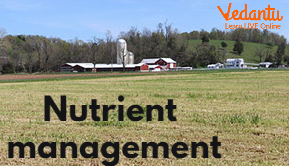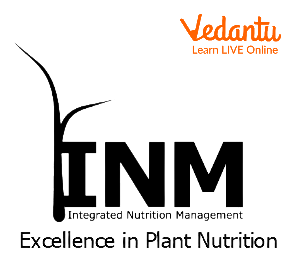Nutrient Management: A Brief Overview
Food is necessary for our health, development, and growth. Like all other living things, plants need nutrition. Water, air, sunshine, and soil all contribute to these nutrients. Some nutrients, known as macronutrients, are needed by plants in vast quantities, while others, known as micronutrients, are needed in lesser amounts. While hydrogen is given by water, gases like carbon dioxide and oxygen are delivered by the air.
Thirteen more micronutrients and macronutrients are provided by the soil, including iron, copper, zinc, chloride, boron, and manganese (calcium, magnesium, potassium, nitrogen, phosphorus), and the 4Rs also play a very important role in nutrition management. The four R's are as follows: right source, right rate, right time, and right place.
What is Nutrient Management?
Utilising agricultural nutrients as effectively as possible helps to increase productivity while preserving the environment. Balancing soil nutrient inputs with crop needs is the fundamental idea behind nutrient management. Added nutrients can help increase crop yields when they are given in the appropriate amounts and at the right times; applying too little will reduce yield while applying too much is inefficient economically and may be harmful to the environment. Ineffectively used nutrients by crops may seep into surrounding surface waterways or leak into the groundwater. For instance, excessive nitrogen or phosporous can harm water quality.

Nutrient Management
INM Definition
Integrated nutrient management (INM) is a strategy that refers to the safest approach to getting rid of crop waste and making high-quality compost by balancing and integrating the usage of both organic and inorganic fertilisers in combination to maintain soil fertility and give plants the optimal quantity of nutrients they need throughout their life cycles to maintain yield productivity.

INM (Integrated Nutrition Management)
Integrated Nutrient Management
The application of chemical fertilisers and organic manures together for crop productivity is known as integrated nutrient management. The preservation of soil fertility and the provision of sufficient plant nutrients are its primary goals. It is socially, environmentally, and economically sound.
Explaining Nutrient Use Efficiency
The capacity of crops to absorb and use nutrients for optimal yields is demonstrated by the concept of nutrient usage efficiency (NUE). As a result, the NUE concept considers three crucial plant processes: nutrient absorption, assimilation, and use.
Components of Integrated Nutrient Management
The components of Integrated Nutrient Management are:
Synthetic fertilisers
Organic manures
Crop rotation and intercropping
Crop residue and organic wastes
Biofertilisers
Green manures

Components for INM
Nutrition Management Objectives
The four R's—right source, right rate, right time, and right place—serve as a road map for farmers to assist them to choose management techniques that help retain nutrients in the soil. The 4Rs' implementation aids in balancing the nutrient management process's economic, environmental, and social aspects.
Interesting Facts
The 4R Nutrient Stewardship concept relates management practices—selection of nutrient source, rate, timing, and placement - to sustainability goals at all levels.
A variety of preciseness ag tools support the 4Rs by serving farmers to exactly monitor and meet crops' nutrient needs, such as soil sensors, variable rate prescriptions, yield maps, decision support software, soil mapping, multispectral imaging, auto-guidance systems, and leaf colour charts.
Conclusion
It's a well-known fact that soil plays a major role in agriculture. The primary factor affecting the output and productivity of the crop is the soil's nutritional condition. The quantity of nutrients that a plant can absorb affects how much of a crop is produced. Even when the soil's nutritional status is good, a plant may occasionally be unable to absorb the needed nutrients because of a variety of other circumstances. Therefore, these elements need to be taken into account in integrated nutrition management. It is important to accurately trace the plant's nutrient flow in the soil and plant.


FAQs on Nutrient Management
1. What is meant by Nutrient Management in agriculture?
Nutrient management in agriculture is the process of using crop nutrients as efficiently as possible to improve productivity while protecting the environment. It involves managing the source, rate, timing, and method of nutrient application to crops to ensure they get what they need for healthy growth without excess runoff into waterways.
2. What is the main difference between macronutrients and micronutrients for plants?
The main difference between macronutrients and micronutrients lies in the quantity required by the plant. Macronutrients are needed in large amounts and include elements like Nitrogen (N), Phosphorus (P), and Potassium (K), which are crucial for growth, photosynthesis, and metabolism. Micronutrients, such as iron, manganese, and zinc, are required in very small quantities but are essential for specific functions like enzyme activation and cell processes.
3. What are the primary sources from which plants obtain their essential nutrients?
Plants obtain their essential nutrients from three primary natural sources: air (for carbon and oxygen), water (for hydrogen and oxygen), and soil (for minerals like nitrogen, phosphorus, potassium, and others). To enhance soil fertility, these sources are supplemented with organic materials like manure and compost, or synthetic fertilisers.
4. What is vermicomposting and how does it improve soil health?
Vermicomposting is a natural process where earthworms, like red wigglers, decompose organic waste to create a rich, dark, soil-like material called vermicompost. It improves soil health by being rich in easily absorbable nutrients, enhancing soil aeration and water retention, and introducing beneficial microbes that help suppress plant diseases and improve nutrient cycling.
5. Why is Integrated Nutrient Management (INM) considered a more sustainable approach than relying only on chemical fertilisers?
Integrated Nutrient Management (INM) is more sustainable because it combines the use of organic manures, biofertilisers, and chemical fertilisers in a balanced way. Unlike relying solely on chemical fertilisers, which can degrade soil structure, harm microbial life, and pollute water over time, INM focuses on maintaining long-term soil health. This approach reduces dependency on synthetic inputs, improves nutrient use efficiency, and is more economically and environmentally sound.
6. What are the '4Rs' of Nutrient Stewardship and why are they important?
The '4Rs' of Nutrient Stewardship is a framework for sustainable agriculture. They are important for maximising crop yield and minimising environmental impact. The 4Rs are:
- Right Source: Matching the fertiliser type to crop needs.
- Right Rate: Applying the precise amount of nutrients the crop requires.
- Right Time: Applying nutrients when the crop can best absorb them.
- Right Place: Placing nutrients where the crop's roots can easily access them.
7. How does crop rotation contribute to better nutrient management in the soil?
Crop rotation contributes to better nutrient management by diversifying the nutrient demands on the soil. For example, planting a leguminous crop (like peas or beans) that fixes atmospheric nitrogen in the soil can enrich it for the next crop. A subsequent non-legume crop (like maize) can then utilise this naturally available nitrogen. This practice reduces the need for synthetic nitrogen fertilisers, improves soil structure, and helps break pest and disease cycles.
8. What are the three main types of fertilisers based on the primary nutrient they supply?
The three main types of fertilisers are classified based on the primary macronutrient they provide:
- Nitrogenous Fertilisers: Supply nitrogen, essential for leaf and stem growth (e.g., Urea).
- Phosphatic Fertilisers: Supply phosphorus, crucial for root development, flowering, and seed formation (e.g., Superphosphate).
- Potassic Fertilisers: Supply potassium, which is vital for overall plant health, disease resistance, and water regulation (e.g., Muriate of Potash).










